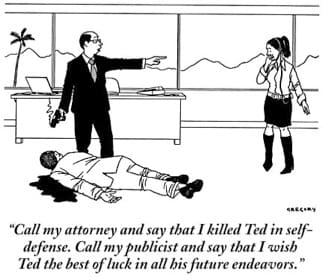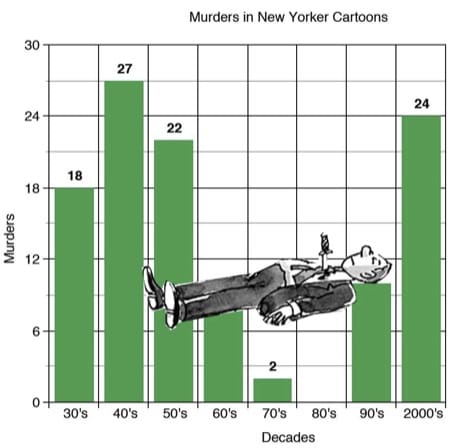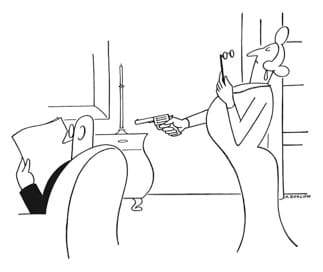 After reading Steven Pinker’s The Better Angels of Our Nature, which claims we’re living in the least violent period in human history, New Yorker cartoon editor Robert Mankoff decided he needed more empirical evidence. How better to gauge violence through the sweep of human history than through the pages of Eustace Tilley’s favorite periodical with its all-encompasing world view? What Mankoff found, though, disturbed him; 111 murders had been depicted in about 76,000 cartoons published since the 1930s. Oh, the humanity…
After reading Steven Pinker’s The Better Angels of Our Nature, which claims we’re living in the least violent period in human history, New Yorker cartoon editor Robert Mankoff decided he needed more empirical evidence. How better to gauge violence through the sweep of human history than through the pages of Eustace Tilley’s favorite periodical with its all-encompasing world view? What Mankoff found, though, disturbed him; 111 murders had been depicted in about 76,000 cartoons published since the 1930s. Oh, the humanity…
 Briefly channeling his inner beancounter, he managed to fire up Lotus 1-2-3 on his IBM PC AT and produce the above graph to track the sketchy slayings by decade. Imagine his horror when the chart revealed a sharp increase in humor-based homicides under his editorship which began in 1997.
Briefly channeling his inner beancounter, he managed to fire up Lotus 1-2-3 on his IBM PC AT and produce the above graph to track the sketchy slayings by decade. Imagine his horror when the chart revealed a sharp increase in humor-based homicides under his editorship which began in 1997.
…I take full responsibility and am committed to reversing this disturbing trend. I’m beefing up police representation in cartoons and imposing the strictest gun-control laws in the cartoon industry. If all that doesn’t work, well, I’ll just make all of our cartoonists read Pinker’s book and get with the program.
It’s good to know that the delicate sensibilities of Upper West-Siders will be well looked after in the venerable weekly on a go-forward basis. At least as long as Mankoff’s on the job. Think of it as simple, common-sense cartoon control.





I still (dimly) remember an animated Woody Woodpecker cartoon in which he expresses his displeasure at someone on his television by pulling out a semiauto pistol and shooting the TV. Entry holes appear on the glass tube, and his “target” sinks out of frame, mortally wounded.
And each subsequent time that the episode airs, it cuts to a commercial before he even gets a chance to draw.
This effort may not be in vain. If only one innocent creature is spared a senseless death in the upcoming duck seaon… or is it rabbit season…. duck season…. rabbit season…
@ Dan Zimmerman: I’m a little puzzled. Mankoff’s piece was blatantly satirical, tongue in both cheeks. Yet you portrayed it here as if he were entirely serious. Was the clearly humorous thrust of the story totally lost on you, or did you decide to deliberately misrepresent it?
I’ll agree with Magoo. The Left has become so much of a self-parody it is difficult to tell when they are being serious, and when they are trying to be funny. We laugh at them anyway, but….
http://en.wikipedia.org/wiki/Poe's_law
I wonder how many of the cartoons from the 40s-60s were Charles Addams’s…
http://2.bp.blogspot.com/_bBDFciBWIFU/Sdg2tf8yF6I/AAAAAAAACYc/ErSSaO-oIBU/s400/medium_Telephone.jpg
http://www.wunderland.com/WTS/Rash/misc/addams.htm
I agree; Mankoff is just trying to be clever, but he ends up being too clever by half. It’s not until the last paragraph that there is any hint he is just joking around. The article is not funny, though it is poking fun at gun control.
@Andy: If you couldn’t tell the story was full-blown satire from the start, the New Yorker might not be the magazine for you. You and Zimmerman might want to stick to Guns and Ammo. It’s a perfectly fine publication.
I’ve never read Guns & Ammo, but if you give it high praise maybe I should consider it.
Thinking that a reader should know the article is “full-blown satire from the start” assumes familiarity with The New Yorker. It may come as a surprize to avid readers of The New Yorker, but a good many people rarely read it because they do not find the periodical worthwhile. Therefore the assumption that this article should have been recognized as satire from the start is not universal.
The New Yorker is worth reading if only for Sy Hersh. He is one of the few journalists left in this country worthy of the title.
Comments are closed.